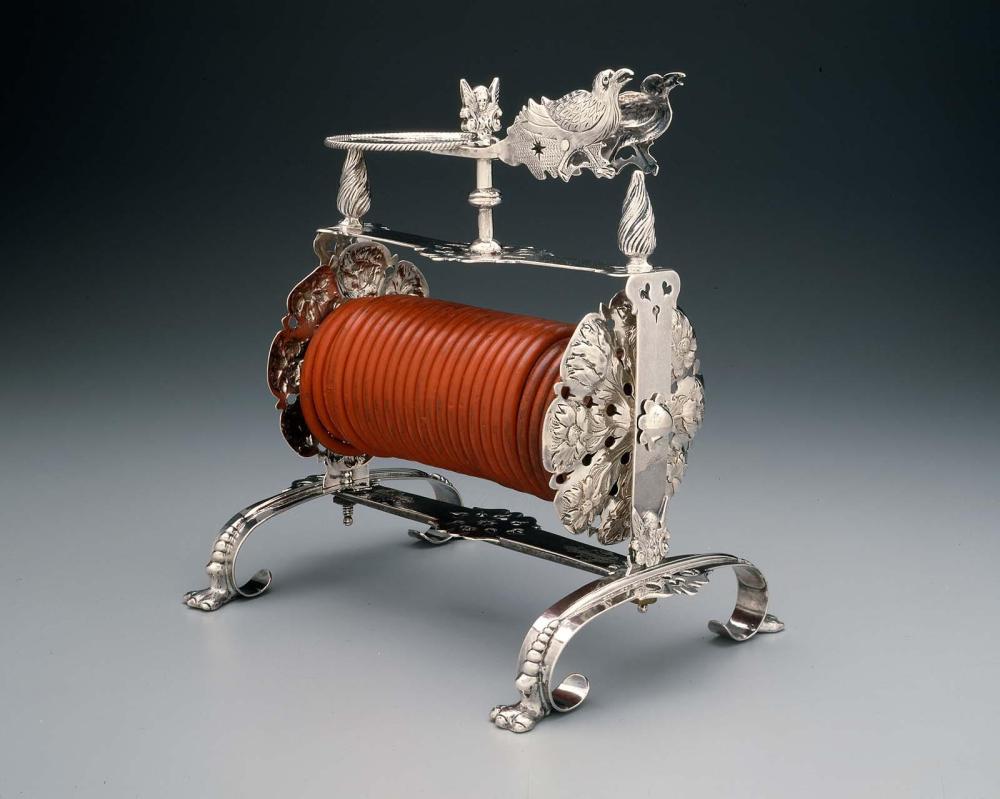Advanced Search
Wax jack
English (London)
about 1675–85
Object Place: Europe, London, England
Medium/Technique
Silver
Dimensions
H. 22.9 cm (9 in.); W. 22.6 cm (8 7/8 in.); D. 16.5 cm (6 1/2 in.); Weight 1,221.9 gm (39 oz 6 dwt)
Credit Line
Theodora Wilbour Fund in memory of Charlotte Beebe Wilbour
Accession Number61.185
CollectionsEurope
ClassificationsSilver
DescriptionThe wax jack consists of a spool in a frame that rests on four feet. The ends of the spool are circular disks of silver, pierced and embossed with naturalistic foliage. The rectangular frame enclosing the spool is formed of flat strips that are pierced with a heart-shaped pattern. The legs are composed of two elongated C-shaped pieces; each foot is in the form of a lion's paw with a beaded appliqué. At the juncture of the legs with the frame, there is a cast ornament in the form of a putto's head. Each end of the frame is surmounted by a finial in the form of a flame. The end of the wax is held in a disk-shaped clamp with a handle in the form of two embossed birds. At the center is a finial in the shape of a putto's head. The central spool has a solid wood core, with silver disks at either end that are formed, embossed, chased, and pierced. They are threaded though the center of the core with a seamed hollow silver rod. The spool is attached to the frame with a second silver rod that runs through the center of the first. The base of the frame is formed of three pieces: the two legs, formed and pierced, with an applied wire and cast feet, and the pierced cross bar, which is soldered to the underside of the legs. The rectangular section of the upper frame is formed of a single piece and pierced; the cast flame finials and putti's head are applied. The frame is attached to the base with posts threaded through a steel bar that rubs underneath the cross bar. A twisted wire is applied to the rim of the clamp; the handles are embossed, chased, and pierced. A steel spring with a decorative outline is riveted to the inside of the handle. The clamp is secured to the frame with a threaded post and a nut in the form of a cast putto's head. The underside of one leg has been patched.
Marks
On top of taper holder, maker's mark PR in monogram a pellet below in a shaped shiled (Jackson, 1921, p. 140; rev. ed. 1989, p. 139) (repeated on underside of each horizontal frame support); leopard's head crowned; lion passant; indecipherable date letter.
Maker's mark could also be a cursive letter I or J.
Maker's mark could also be a cursive letter I or J.
ProvenancePossibly given by Charles II, King of England and Scotland (b. 1630 - d. 1685) to Benjamin Fellows, London (?) [see note 1]; by descent within the family to Colonel C. F. Fellows; December 18, 1930, Fellows sale, Sotheby's, London, to William Permain, London, for William Randolph Hearst (b. 1863 - d. 1951), New York; November 17, 1937, Hearst sale, Sotheby's, London, lot 31, to Tessier for £395. 1961, Mrs. R. Makower; March 16, 1961, posthumous Makower sale, Sotheby's, London, lot 140, sold to Thomas Lumley Ltd., London; 1961, sold by Thomas Lumley to the MFA for £3,600. (Accession Date: April 12, 1961).
NOTES:
[1] According to the 1937 Hearst auction catalogue, "this piece is traditionally believed to have been given by Charles II to an ancestor of the late Colonel Fellows, possibly Benjamin Fellows of the City of London."
NOTES:
[1] According to the 1937 Hearst auction catalogue, "this piece is traditionally believed to have been given by Charles II to an ancestor of the late Colonel Fellows, possibly Benjamin Fellows of the City of London."



